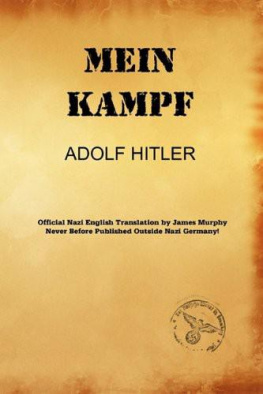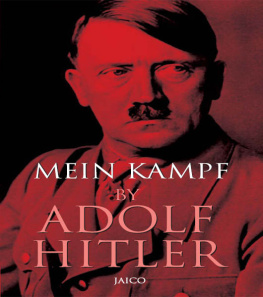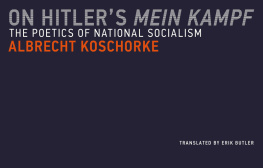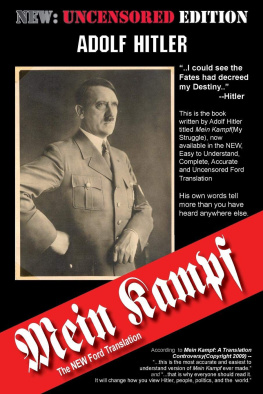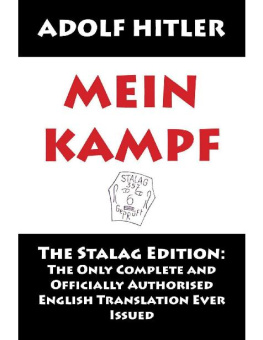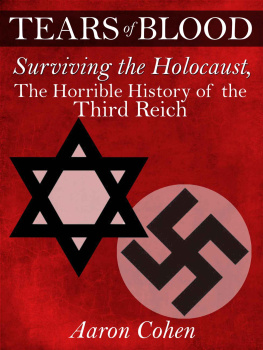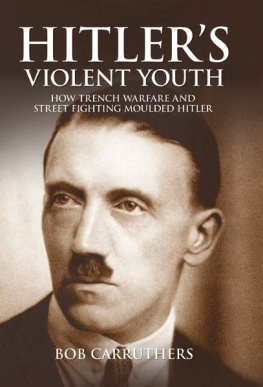Hitlers Mein Kampf and the Holocaust
Perspectives on the Holocaust
A series of books designed to help students further their understanding of key topics within the field of Holocaust studies.
Published:
Holocaust Representations in History (2nd edition), Daniel H. Magilow and Lisa Silverman
Postwar Germany and the Holocaust, Caroline Sharples
Anti-Semitism and the Holocaust, Beth A. Griech-Polelle
The Holocaust in Eastern Europe, Waitman Wade Beorn
The United States and the Nazi Holocaust, Barry Trachtenberg
Witnessing the Holocaust, Judith M. Hughes
Hitlers Mein Kampf and the Holocaust: A Prelude to Genocide, John J. Michalczyk, Michael S. Bryant, and Susan A. Michalczyk (eds.)
Forthcoming:
Sites of Holocaust Memory, Janet Ward
Dedicated to Jacques Salmanowitz (18841966)
Jacques Salmanowitz, a Swiss businessman, was instrumental in bringing to safety in Switzerland many individuals trapped behind German lines in the Second World War.
Hitlers Mein Kampf and the Holocaust
A Prelude to Genocide
Edited by
John J. Michalczyk,
Michael S. Bryant, and
Susan A. Michalczyk
Contents
Karla Schnebeck
Othmar Plckinger
Magnus Brechtken
Paul Bookbinder
Nathan Stoltzfus and J. Ryan Stackhouse
John J. Michalczyk
Ralf Yusuf Gawlick and Barbara S. Gawlick
Michael S. Bryant
David M. Crowe
Melanie Murphy
Susannah Heschel
Martin Menke
David Redles
Tetyana Hoggan-Kloubert
Hitler, released from prison, poses in front of the Bavarian Tower in Landsberg |
Hitler returns to Landsberg in 1934 |
Father Karl Morgenschweis prays for condemned prisoners on the gallows |
Theodor Fritsch, Handbuch der Judenfrage (The Handbook of the Jewish Question) |
Theodor Fritsch (18521933) was a journalist and publisher of anti-Semitic writings such as The Protocols of the Elders of Zion and Henry Fords International Jew , besides The Handbook of the Jewish Question25 |
Institut fr Zeitgeschichte (Institute of Contemporary History), Munich, Germany: staff members at a cabinet with building plans from the Third Reich, c . 1950 |
One People, one Reich, one Fhrer/Leader: Image of authority |
SA/Sturmabteilung storm troopers in action |
Blut und Boden (Blood and Soil) was the 1930s slogan for a program that combined racial ideals with the land |
In 1933, Jewish businessman Oskar Danker and his girlfriend, a Christian woman, were forced to carry signs discouraging Jewish-German integration |
Photo of biracial girl used in lectures at Germanys State Academy for Race and Health |
Aryan certificate ( Ariernachweis ) stating that one is of Aryan bloodline |
Publicity for the Entartete Kunst /Degenerate Art exhibition: Otto Freundlichs sculpture Der Neue Mensch |
Exhibition poster for the 1938 Entartete Musik exhibition |
Rare dust jacket cover of the first edition of Mein Kampf . As the editors of the critical edition observe, the portrayal of Nazisms enemies as serpents directly evokes the coarse anti-Semitic imagery of the German folk-national movement |
Behind the enemy powers: The Jew |
The Eternal Jew exhibition in Munich, November 1937. The image reflects the Bolshevik monetary and political power over the masses |
Hubert Langziners portrait of Hitler as The Standardbearer ( Der Bannertrger ) |
Cardinal Michael Ritter von Faulhaber in 1937 helped draft the Vatican encyclical Mit Brennender Sorge (With burning concern) of Pope Pius XI against racism |
Dietrich Eckarts Jewish beast of the apocalypse, portrayed as a combination of the Midgard serpent from Ragnarok and the dragon, that ancient serpent, from Revelation 20 |
Entrance to the Auschwitz concentration camp ( Arbeit macht frei /Work makes one free) |
When a person gives, he needs to take, Adolf Hitler once said, and I take what I need from books. Hitler was a voracious reader. By the time of his suicide in April 1945, he owned an estimated 16,000 volumes in 3 private libraries, at the Reich Chancellery in Berlin, at his Prinzregentenplatz apartment in Munich, and at the Berghof, his alpine retreat on the Obersalzberg. His private secretary, Traudl Junge, once told me that she remembered Hitler reading a book a night, which he invariably and tediously reprised for her the following morning at breakfast. Books, always more books! I can never remember Adolf without books, a Hitler associate from his teenage years recalled. They were his world.
There was no book more central to Hitlers life and identity than Mein Kampf. There is no event more central to his legacy than the Holocaust. For these reasons, this volume represents a welcome and important addition to the vast literature on the former Nazi leader and the Holocaust, in particular. While Mein Kampf is often discussed as a self-serving and unreliable autobiography or an impossibly ponderous and impenetrable political manifesto, and frequently referenced as a source for understanding the nature of Hitlers anti-Semitism, this volume represents the first systematic examination of Mein Kampf with specific focus on the Holocaust.
The editors, John J. Michalczyk, Michael S. Bryant, and Susan A. Michalczyk, have enlisted an impressive range of scholars and researchers, indeed some of the worlds leading authorities on Mein Kampf, to consider the origins, sources, impacts, and implications of this infamous treatise, from the nineteenth century to our own day. Through the individual chapters we come to understand the place of Mein Kampf not only within the personal life and career of its author but equally important within the broader context of German society. The contributors trace the origins of European racial theories more broadly and examine how these theories found their most extreme expression in Hitlers words and policies. These chapters help illuminate Hitlers personal manifesto, a work that can be as impenetrable as it is repulsive, with the advantage of allowing one to explore Mein Kampf without subjecting oneself to the punishing experience of reading the original.
Timothy W. Ryback
Author, Hitlers Private Library:
The Books That Shaped His Life
Berlin, Spring 2021
As a collective effort of many individuals, our text reflects not only the ideas and extensive scholarship of our contributors but also the work of other individuals who understood the importance of coming to terms with the evolution of Hitlers mindset in the early 1920s as a prelude to the Holocaust. In hosting the Boston College conference at which our contributors offered a lecture and an interview for our accompanying documentary on the subject, Boston College, Bryant University, and Brandeis University provided funding for both travel and lodging. Monetta Edwards of the Carroll School of Management assisted significantly with financial details at Boston College, while Michael Bryant of Bryant University and Sabine von Mering did the same for their part of the sponsorship. To document the conference Robert Heim filmed the interviews while Michael Resler and Susan Michalczyk conducted them for our companion documentary,


